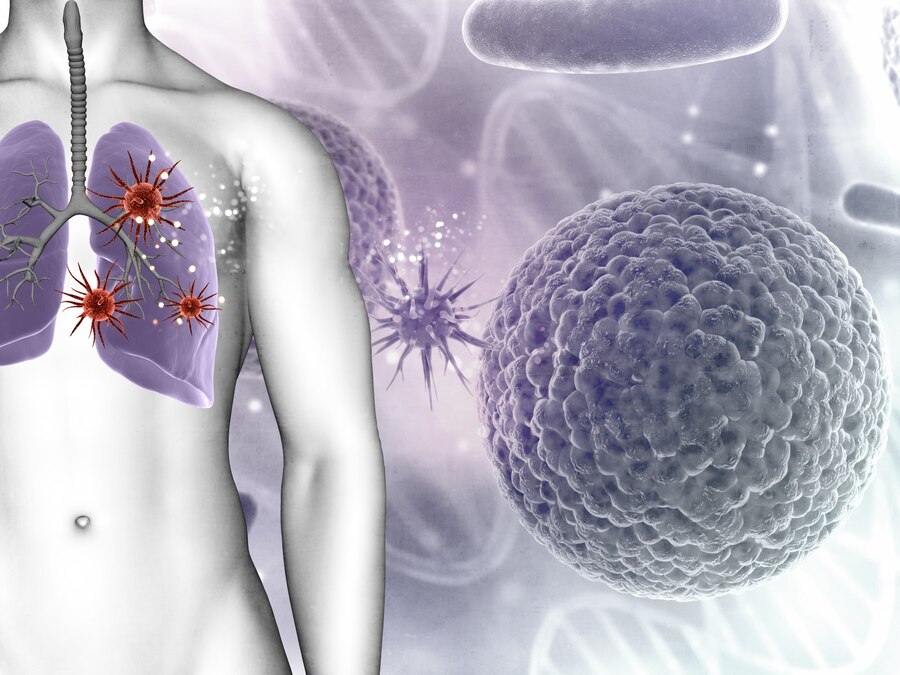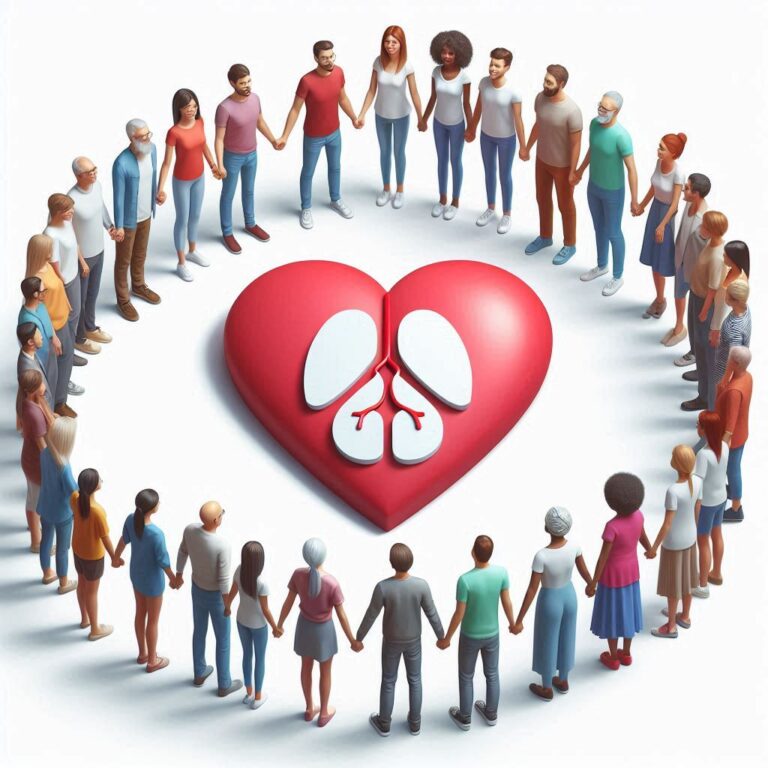Introduction
Lung cancer has been one of the greatest health challenges throughout our lifetime. It claims a large number of those who succumb to cancer. Raising awareness is important in order to fight such a pervasive disease by empowering people and communities with self-care; it helps in knowing its causes, symptoms, treatment options, and prevention, which may lead to its early detection and making informed choices. The article enlightens us about various aspects of lung cancer, from the key risk factors such as smoking and hazards in the environment to the more subtle symptoms that are oftentimes overlooked until it has advanced in stage. New and upcoming treatment options are also discussed, with emphasis on the call for preventive measures. We join in the fight against lung cancer—the knowledge being a very powerful weapon in fighting for life and health. Together, we can work for a future where lung cancer no longer dominates as a leading cause of death but becomes a chronic yet manageable condition, and eventually, a preventable one.
Lung Cancer: A Deadly Threat
Lung cancer remains a leading cause of cancer-related death worldwide. Statistics depict a very gloomy picture of its prevalence and mortality rate. The disease majorly is predisposed to smokers, though it can also occur in non-smokers due to risk factors like second-hand smoke, occupational hazards, and polluted air. Although these rates have been falling in some countries due to a reduction in smoking, it continues to kill millions of people worldwide. The major factors influencing survival rates are early detection through regular screenings and quitting smoking. Much-needed awareness campaigns and continued research alone can fight this killer disease.
Join the Fight against Lung Cancer
Lung cancer is a silent killer that has claimed many lives for years. The time to break the silence is now. This nasty disease does not look at the age, background, or life position; it hits them all with no difference. It is a war in which there needs to be a united front in fighting lung cancer.
We fund critical research, raise awareness, and provide vital support to patients and their loved ones. Join the fight to help develop groundbreaking treatments, early detection methods, and quality of life for those affected by lung cancer.
Together, we can create a future where lung cancer no longer has to mean a death sentence. Join us in the quest for a cure. Every little bit helps in bringing relief. Let’s blow life into the fight against lung cancer.
Join the movement today.
Definition of lung cancer
Lung cancer refers to a type of cancer that primarily develops in the lungs. The lungs are two organs in the cavity of the thorax, which are responsible for breathing and exchanging gases. Lung cancer occurs when cells in the lung tissue begin to grow wildly without control, ultimately forming tumors that can impede normal functioning of the lungs. Lung cancer is linked to smoking, even though it also happens in people who have never smoked because of passive exposure, polluted environment, genetics, and other previous health conditions.
Types of Lung Cancer
The classification of lung cancer is mostly divided into two types based on the kind of cells in the tumour:
Non-Small Cell Lung Cancer: This is the most common, accounting for about 85% of all cases of lung cancer. NSCLC is further divided into several subtypes, including:
Adenocarcinoma: This is the most prevalent type; it is generally observed in those patients who do not smoke. It originates in the cells lining the airways with glands and frequently occurs in the outer areas of the lungs.
Squamous Cell Carcinoma: This kind of cancer is associated with smoking. It develops within the squamous cells lining the airways and hence it is common in the middle part of the lungs.
Large Cell Carcinoma: This is a less frequent and more aggressive type of cancer, and it crops up at any point in the lungs. Another type of lung cancer is SCLC, which accounts for a smaller percentage of lung cancers. It is more aggressive and spreads more quickly than the aforementioned one. The link with smoking is very strong in this type. It is usually divided into two stages: limited stage, wherein it is localized, and extensive stage, wherein it has spread to other distant sites.
Lung Cancer Staging
The lung cancer has to be staged to measure the extent of the disease, form a treatment plan, and predict outcomes. One of the most commonly used staging systems for lung cancer includes the TNM system, proposed by the American Joint Committee on Cancer. It will describe the following:
T—Tumor: Describes the size and extent of the primary tumor. This is further subdivided into classes T1, where the tumors are relatively small in size and localized, and T4, where the tumors are rather big and can also invade adjacent organs or structures.
N Nodes: Describes if the cancer has invaded nearby lymph nodes. This can range from as low as N0, which is no involvement of the lymph nodes, to N3, meaning that the involvement in the lymph nodes is extensive.
M Metastasis: Describes the extent to which the cancer has spread to far parts of the body. M0 describes no distant metastases, and M1 shows that the metastasis has occurred.
Lung Cancer Stages
The usual staging is from Stage 0, in situ, to Stage IV, representing advanced or metastatic diseases based on the TNM classification. Stage 0: It is called carcinoma in situ; thus, the cancerous cells are present but remain confined within the ducts, not invading the tissues surrounding it. Stage I: The cancer is localized, and it does not seem to spread to the lymph nodes or any other organs in the body and is confined to the lung.
Stage II: The tumor is bigger, and the cancer may have spread to lymph nodes nearby.
Stage III: Advanced cancer, involving possibly multiple lymph nodes, or a single lymph node plus local structures.
Stage IV: The cancer has spread to faraway organs, such as the liver, bones, or brain.
An understanding of the definition, types, and staging of lung cancer forms the basis for diagnosis, treatment planning, and management of the disease. In most cases, patients with lung cancer can have much improved outcomes if the disease is detected early and treated accordingly.
Causes of Lung Cancer
Lung cancer is a complex disease, resulting from several risk factors that often act interdependently to cause the disease. The main causes of lung cancer are:
Cigarette smoking is responsible for prompting lung cancer in people. It substantially heightens the risk not only among active smokers but also among those who are regularly exposed to secondhand smoke. Individuals who smoke pipes or cigars or use other tobacco products are also at risk.
Exposure to Radon Gas: Radon is a naturally occurring radioactive gas that builds up in houses and buildings. Prolonged exposure to high levels of radon gas increases the risk of developing lung cancer.
Occupational Exposure: Certain places of work expose one to carcinogens, which raise the risk of lung cancer, including:
• Asbestos
• Arsenic
• Chromium
• Nickel
• Diesel exhaust
• Formaldehyde
Air Pollution: This is concerned with the long-term exposure to outdoor air pollution, particularly exposure to fine particulate matter PM2.5 and other pollutants, which appear to raise the risk of lung cancer.
Genetic Factors: One’s family history regarding lung cancer may predispose an individual to a greater risk; hence, genetic predisposition does play its role in being susceptible to the disease.
Pre-Existing Conditions of the Lung: Diseases such as chronic obstructive pulmonary disease and pulmonary fibrosis increase the risk of lung cancer.
Age: The risk for lung cancer increases with age, and the majority of the cases are diagnosed over 65 years of age.
Chest Radiation Therapy: A person who has undergone radiation therapy to the chest region for other cancers may be at increased risk for lung cancer.
Weakened Immune System: People with weakened immune systems, either due to diseases such as HIV/AIDS or as a side effect from medications like those taken after organ transplants, could have an increased risk of lung cancer.
Symptoms of Lung Cancer
Lung cancer symptoms vary by type and stage of cancer. Some common symptoms may include:
Persistent Cough: A cough that doesn’t seem to go away or gets worse over time.
Chest Pain: Pain that might increase upon deep inhalation, coughing, or laughing. Shortness of Breath: Having difficulty breathing or experiencing shortness of breath when performing regular activities. Wheezing: Producing a rasping or whistling sound in the process of breathing. Coughing Up Blood: Hemoptysis or blood-tinged sputum is another alarming symptom for which immediate consultation is required. Unexplained Weight Loss: Loss of weight without trying can be a sign of cancer.
Fatigue: Persistent weakness and tiredness that doesn’t improve with rest.
Recurring Infections: Pneumonia, bronchitis, or other recurring infections
Hoarseness: Changes in the voice, such as hoarseness, that last longer than a few weeks.
Swelling: Swelling in the face or neck because the superior vena cava is blocked by tumors.
Diagnosis of Lung Cancer
Lung cancer diagnosis mainly involves tests for symptoms, beginning with a medical history, physical examination, radiographic studies, and investigations to establish diagnosis. This is how it happens:
Medical History and Physical Examination:
A health care provider will ask about symptoms, such as persistent cough, chest pain, shortness of breath, weight loss, etc., smoking history, exposure to environmental toxins like asbestos, and a family history of lung cancer.
The physical examination may be done to look for the classical signs of respiratory tract pathology or metastasis.
Imaging Studies:
Chest X-ray: This is often the initial imaging study used to identify abnormal masses or nodules.
CT Scan: Computed Tomography—This is a noninvasive test that produces detailed cross-sectional images of structures within the chest to facilitate ascertainment of the size, shape, and exact location of tumors in the lungs. Positron Emission Tomography (PET) Scan: It is done in conjunction with a CT scan, showing whether cancer has spread to other areas of your body. It enables one to see if the suspected tumors have metabolic activity. Sputum Cytology:
In some cases, a sample of sputum (mucus coughed up from the lungs) may be looked at under a microscope for cancer cells.
Biopsy:
This is the surest way to tell if someone has lung cancer.
The types of biopsy include:
Bronchoscopy: Passing a thin tube through the airways into the lung to collect tissue samples.
Needle Biopsy: Tissue is withdrawn with a needle and is usually guided by imaging.
Surgical Biopsy: This involves the removal of a larger portion of the lung tissue and is usually carried out if other methods prove inconclusive.
Molecular Testing:
Tissue samples may be analyzed at a molecular or genetic level to identify specific mutations that may help tailor treatment options.
Treatments for Lung Cancer
Treatment alternatives for lung cancer depend on several factors, which include the type and stage of the cancer, general health of the patient, and individual preferences. The basic treatment alternatives for lung cancer are mainly included as the follows:
Surgery:
Lobectomy: This is an operation where a lobe of the lung is removed (done in most instances of non-small cell lung cancer)
Pneumonectomy: This is where the whole lung is removed
Wedge Resection: A piece of the lung is removed.
Video-Assisted Thoracoscopic Surgery VATS: This is a minimally invasive approach applied in performing some surgeries.
Radiation Therapy:
External Beam Radiation Therapy: The radiation in this case hits the cancer cells from outside one’s body.
Stereotactic Body Radiotherapy SBRT: It involves radiation being delivered in high doses precisely to the tumor.
Proton Therapy: In this kind of therapy, protons are used instead of X-ray energy in treating the tumor.
Chemotherapy:
Often used for small cell lung cancer and can be given before or after surgery. Common regimens may include combinations of cisplatin, carboplatin, paclitaxel, gemcitabine, and etoposide.
Targeted Therapy:
For patients with specific genetic mutations, targeted therapies can block the growth of cancer cells. Examples include EGFR inhibitors such as erlotinib and gefitinib, and ALK inhibitors such as crizotinib and alectinib, among others.
Immunotherapy:
Uses the body’s immune system in fighting cancer. The drugs pembrolizumab, nivolumab, and atezolizumab can be applied for some types of lung cancer, mainly at an advanced stage.
Clinical Trials:
For patients desiring new treatments or several combinations of treatments undergoing clinical evaluation, participation in a clinical trial may be a treatment option.
Palliative Care: This approach aims to alleviate symptoms, enhancing the quality of life of patients, notwithstanding the degree of cancer spread.
Prevention Strategies for Lung Cancer
The prevention factors of lung cancer are majorly risk reducible factors; subsequently leading to healthier behaviors on lifestyle. There are several steps that can be undertaken to reduce the prevalence of lung cancer. They involve the following:
1.· Controlling Tobacco
Quitting Smoking: A factor with the most effective way to reduce risk, quitting tobacco causes a significant risk reduction at any age of quitting.
Avoiding Secondhand Smoke: This should be achieved by avoiding environments in which tobacco is being smoked and encourage its cessation.
2.· A Good Diet
Add More Fruits and Vegetables: Diet high in fruits and vegetables can minimize the risk of lung cancer. This objective makes a difference in the color and types of these groups, further increasing the value of nutrients.
Avoid Processed Foods: Limit the amount of processed and red meats that increase the likelihood of developing cancer.
3. Activity
Maintain Physical Activity: This is beneficial for health in general and can decrease the risk for the development of cancer.
4. Awareness of Environment
Decrease Exposure to Air Pollution: Spend less time in polluted areas, and support policies that ensure that the air we breathe is cleaner.
Avoid Exposure to Radon: Have homes tested for radon gas, particularly if high recorded levels have been found in the area. Consider mitigation if tests show radon at elevated levels.
Reduce Exposure to Asbestos: Stay away from places that contain asbestos, and, when this cannot be avoided, take necessary safety precautions.
5. Regular Medical Check-Ups
Routine Screenings: If you’re at high risk (e.g., chronic smoker), discuss your available options for lung cancer screening, including low-dose CT scans, with a healthcare provider.
6. Occupational Safety
Observe Safety Measures: If in hazardous occupations like construction or mining, take safety measures to reduce carcinogenic exposures.
7. Limit Alcohol Consumption
Drink Moderately: Yet another way to lower the risk of cancer could be by limiting alcohol intake.
8. Vaccinations
Consider Vaccinations: Vaccines for some infections, such as the HPV vaccine, may have an indirect effect on decreasing the risk for cancers caused by those infections.
9. Genetic Counseling
Know Your Family History: Genetic counseling can clarify personal risk factors, particularly in families who have a history of lung cancer.
10. Stay Informed
Educate Yourself: Be informed about the risks of and ways to prevent lung cancer to make healthier lifestyle choices.
By incorporating all these measures, one can considerably reduce their chance of getting lung cancer. It is always advisable to discuss with health professionals your own, tailor-made prevention plans, more so for people at a high risk.
Conclusion
Awareness and education on lung cancer vis-a-vis the time of diagnosis are critical points in the fight against this disease. Moreover, it is highly important that the risks be realized and signs of lung cancer be identified at an early stage, and awareness of screening be given. It empowers individuals to make informed decisions and urges communities to care for one another in the fight against lung cancer.
We implore our readers to take initiative in their lives and the surrounding communities. Engage in sharing information, participating in local activities that permit it, and advocating for better research and resources. Every little counts, and your voice can play a very important part in raising awareness. Ultimately, it is all up to us in this fight against lung cancer. From banding together with health professionals to funding research and making open conversations about lung health a priority, we can work toward creating an educated society. Together, we may make a difference to ensure fewer lives are affected by this disease and thus nurture hope for a future with improved outcomes for all those affected by lung cancer.
Consult with Apollo Clinic Jessore Road’s Doctors, top oncology specialists in Kolkata, if you are experiencing any of these issues. Visit www.apollojessoreroad.in/oncology




